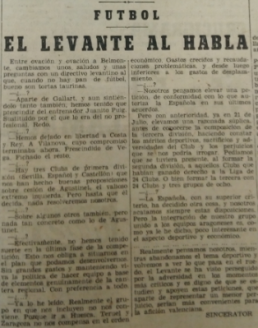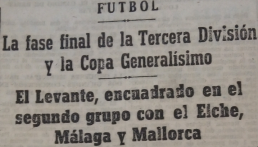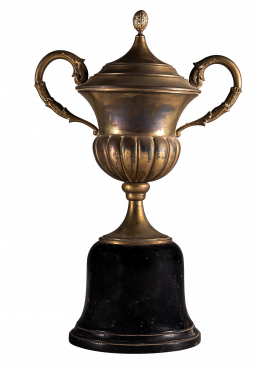The trophy stands the test of time as if trying to recall another football and another Levante distanced from the current one. The front of the trophy reads: Federación Valenciana de Fútbol. Campeonato Regional 1ª Categoría. Season 1943-1944. The legend is illustrative. The Levante team put the competition on a hierarchical level. Their numbers were overwhelming. Their dominance was unquestionable from start to finish. There was no uncertainty.
The team that Redó coached was crowned to glimpse their rivals from the top of the standings. In fourteen matches, they won nine times, drew four times and were beaten only once. They closed the league campaign with a total of twenty-two points and forty-three goals. Carcagente followed in their footsteps from a distance with seventeen. However, we should point out the sense of that competition with an accentuated Valencian flavour by virtue of the rivals assembled: Carcagente, Olímpico de Xàtiva, Acero, Nules, Sueca, Onteniente and Torrent.

We have to go back to the summer of 1943. The Spanish Football Federation Steering Committee rescued the Third Division format. This category had not existed in the previous year. Below the Second Division, the 1st Regional Division emerged. According to the agreements stipulated for the 1943-1944 financial year, a Third Division was organised in eight groups. Levante formed part of group V together with the Aragonese representation and Acero, Carcagente, Sueca and Olimpic de Xàtiva. This was the origin of a fierce protest on the part of the Granotas’ leaders.
The criterion presented was strictly economic, based on the distance of the trips for the matches against the Aragonese teams. Levante had to visit Teruel, Zaragoza and Huesca. The complaint was based on the legality of the established provisions. Clubs could verbalise their reasoning within the time limits stipulated by football’s governing body. Levante made use of this power to submit a request for a change to Madrid.
However, their movements were prior to the pacts reached by the Federation. “Previously, on 21 July, we submitted a reasoned plea before the composition of the Third Division was known, stating the sporting merits, the sacrifices and adversities of the club and the harm that could be done to us. We asked that those Clubs that had earned the right to the League of 24 Clubs be taken into account when forming the Second Division. Or else form the Third Division with 24 Clubs and three groups of eight”, a Levante director pointed out in the Diario Deportes on 30 July 1943.

“The Spanish, with its superior criteria, has decided otherwise and we always abide by these dispositions, but the integration of our group together with Aragonese teams is not very interesting in sporting and economic terms”, he said. The pleas were heard and the Spanish Federation opted to form two sub-groups that would bring together the representatives of the Aragonese and Valencian regions without clashing with each other. Hence, foreseeably, the front that identifies the Cup, 1st Category Championship, and its affiliation to the Valencian Federation.
The winners of each subgroup would play a play-off to decide the Group V champion. Levante disputed the title against Atlético Zaragoza in a dual confrontation that began on 30 January 1944 in the capital of Zaragoza. On the Torrero pitch, they gained the advantage after Pastor’s goal. On 13 February in Vallejo they reduced their opponents to ashes (4-0) with goals from Ricart, Pastor, Segarra and Mamblona.
The triumph took the Granota team to the Final Phase of Promotion to the Second Division alongside Elche, Málaga and Mallorca. Levante did not achieve success through this route. However, the team had one last bullet that took them to the Metropolitano with Baracaldo as their opponents. The Basque triumph distanced the Blaugrana team from the longed-for promotion.
